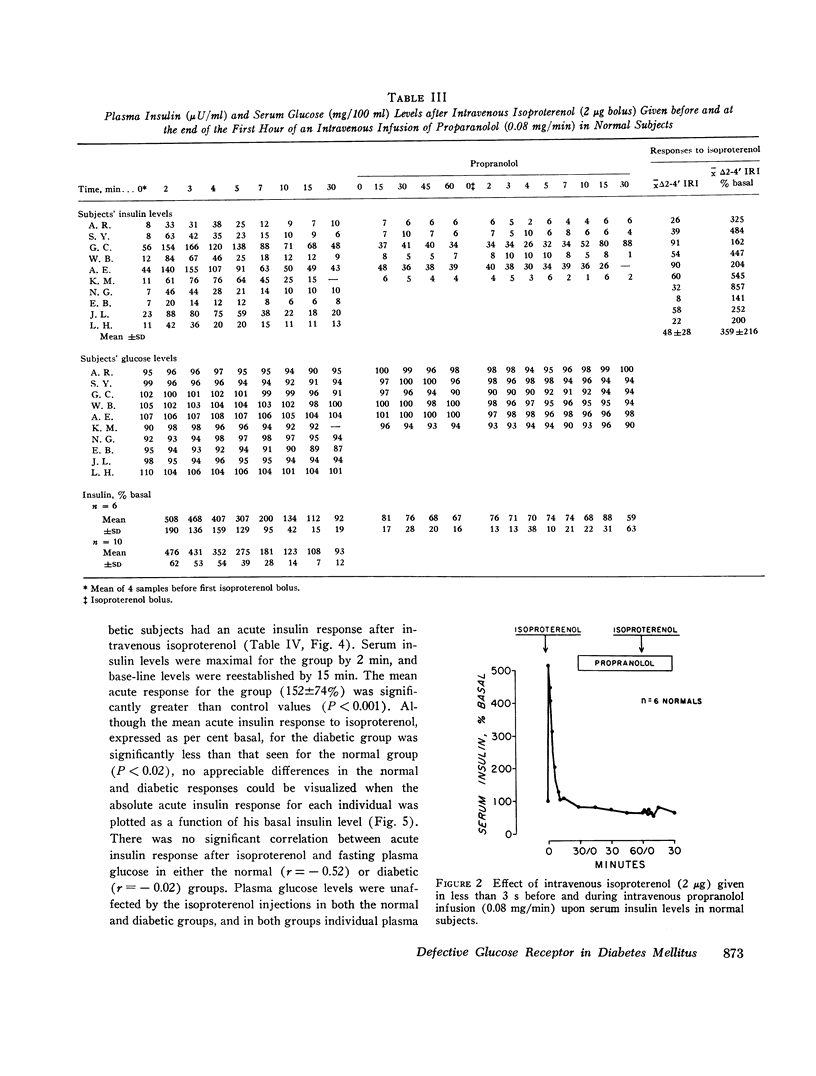Abstract
Acute serum insulin responses in 10 normal subjects after rapid intravenous injection of glucose (5 g) or isoproterenol (2 μg) were of similar magnitude and timing (glucose: 431±349%; mean Δ3-5′ insulin (IRI)±SD, per cent basal and isoproterenol: 359±216%; mean Δ2-4′ IRI±SD, per cent basal). To elucidate the relationship of glucose-induced insulin secretion to pancreatic beta adrenergic receptors and the implications of this relationship with regards to abnormal insulin secretion in diabetes mellitus, two questions were studied. (a) To determine whether glucose-induced insulin secretion is dependent upon beta adrenergic activity, the effect of beta adrenergic blockade with intravenous propranolol (0.08 mg/min) upon acute insulin responses to isoproterenol and glucose were compared in normal subjects. (b) To determine whether acute insulin responses to beta adrenergic stimulation were intact in diabetes mellitus, the effect of isoproterenol upon serum insulin levels was studied in diabetic subjects. Beta adrenergic blockade in the normal subjects obliterated acute insulin responses to isoproterenol (before: 361±270%, during: - 31±15%; n = 6, P < 0.001) but did not significantly affect responses to glucose (before; 311±270%; during: 284±206%; n = 5). The mean acute insulin response after isoproterenol in the diabetic group was significantly elevated over basal levels (152±74%; n = 10, P < 0.001) but the response after glucose was not (- 11±11%). These data suggest that insulin responses to glucose in normal subjects are mediated by specific pancreatic glucose receptors which are independent from beta adrenergic receptors and that abnormal glucose-induced insulin secretion in diabetics is due to defects within glucose receptors and not beta adrenergic receptors as has been previously hypothesized.
Full text
PDF






Selected References
These references are in PubMed. This may not be the complete list of references from this article.
- Bagdade J. D., Bierman E. L., Porte D., Jr The significance of basal insulin levels in the evaluation of the insulin response to glucose in diabetic and nondiabetic subjects. J Clin Invest. 1967 Oct;46(10):1549–1557. doi: 10.1172/JCI105646. [DOI] [PMC free article] [PubMed] [Google Scholar]
- Cerasi E., Effendic S., Luft R. Role of adrenergic receptors in glucose-induced insulin secretion in man. Lancet. 1969 Aug 9;2(7615):301–302. doi: 10.1016/s0140-6736(69)90059-2. [DOI] [PubMed] [Google Scholar]
- Cerasi E., Luft R., Efendić S. Effect of adrenergic blocking agents on insulin response to glucose infusion in man. Acta Endocrinol (Copenh) 1972 Feb;69(2):335–346. doi: 10.1530/acta.0.0690335. [DOI] [PubMed] [Google Scholar]
- Cerasi E., Luft R. The effect of an adenosine--3'5'--monophosphate diesterase inhibitor (aminophylline) on the insulin response to glucose infusion in prediabetic and diabetic subjects. Horm Metab Res. 1969 Jul;1(4):162–168. doi: 10.1055/s-0028-1095148. [DOI] [PubMed] [Google Scholar]
- Deckert T., Lauridsen U. B., Madsen S. N., Deckert M. Serum insulin following isoprenaline in normal and diabetic persons. Horm Metab Res. 1972 Jul;4(4):229–232. doi: 10.1055/s-0028-1094054. [DOI] [PubMed] [Google Scholar]
- Matschinsky F. M., Landgraf R., Ellerman J., Kotler-Brajtburg J. Glucoreceptor mechanisms in islets of Langerhans. Diabetes. 1972;21(2 Suppl):555–569. doi: 10.2337/diab.21.2.s555. [DOI] [PubMed] [Google Scholar]
- Simpson R. G., Benedetti A., Grodsky G. M., Karam J. H., Forsham P. H. Stimulation of insulin release by glucagon in noninsulin-dependent diabetics. Metabolism. 1966 Nov;15(11):1046–1049. doi: 10.1016/0026-0495(66)90055-2. [DOI] [PubMed] [Google Scholar]


